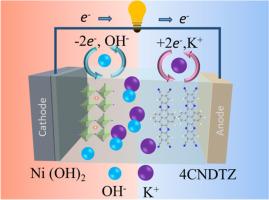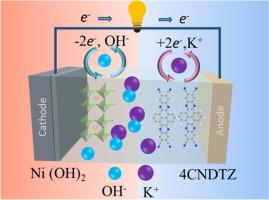Engineering electron cloud density of phenazine for high-voltage and long-life alkaline batteries
IF 18.9
1区 材料科学
Q1 CHEMISTRY, PHYSICAL
引用次数: 0
Abstract
Alkaline aqueous batteries, with intrinsic high safety and potential for high voltage, have always been a hot research topic. Despite several generations of development of anode materials, they still face the challenge of poor cycling stability. Imines have a significant advantage in stability compared to other n-type materials, but their potential is not low enough compared to metal anodes. Herein, a symmetrically structured, extended π-conjugated imine compound, namely cyano-substituted dotriaconta tetrazaoctacyclo (4CNDTZ), was synthesized for the first time and evaluated as the anode materials for alkaline aqueous batteries. 4CNDTZ exhibits a remarkable capacity of 250 mAh g-1 at 0.2 A g-1, coupled with a remarkably low plateau potential of -0.81 V (vs. SHE), significantly below that of conventional alkaline battery anodes. Advanced characterization techniques alongside theoretical calculations confirm that the active sites crucial for its performance are the C![]() N and
N and ![]() CN groups, driving an oxidation–reduction process involving the transfer of 4 K⁺ and 4 electrons. When coupled with Ni(OH)2 cathode, the full cells exhibit a discharge voltage plateau of 1.17 V, allowing the full cells to achieve an energy density of up to 170 Wh kg-1 and sustain stable operation through 10,000 cycles.
CN groups, driving an oxidation–reduction process involving the transfer of 4 K⁺ and 4 electrons. When coupled with Ni(OH)2 cathode, the full cells exhibit a discharge voltage plateau of 1.17 V, allowing the full cells to achieve an energy density of up to 170 Wh kg-1 and sustain stable operation through 10,000 cycles.


用于高电压和长寿命碱性电池的酚嗪电子云密度工程学
碱性水溶液电池具有内在的高安全性和高电压潜力,一直是热门研究课题。尽管正极材料已经发展了几代,但它们仍然面临着循环稳定性差的挑战。与其他 n 型材料相比,胺类材料在稳定性方面具有明显优势,但与金属阳极相比,其电势还不够低。本文首次合成了一种对称结构的扩展π共轭亚胺化合物,即氰基取代的点三尖杉四氮杂辛环(4CNDTZ),并将其作为碱性水电池的阳极材料进行了评估。4CNDTZ 在 0.2 A g-1 的条件下显示出 250 mAh g-1 的惊人容量,同时还具有-0.81 V(相对于 SHE)的极低高原电位,大大低于传统碱性电池阳极的电位。先进的表征技术和理论计算证实,对其性能至关重要的活性位点是 C=N 和 -CN基团,它们驱动着一个涉及 4 K⁺和 4 电子转移的氧化还原过程。当与 Ni(OH)2 阴极耦合时,完整电池的放电电压达到 1.17 V,使完整电池的能量密度高达 170 Wh kg-1,并能在 10,000 次循环中保持稳定运行。
本文章由计算机程序翻译,如有差异,请以英文原文为准。
求助全文
约1分钟内获得全文
求助全文
来源期刊

Energy Storage Materials
Materials Science-General Materials Science
CiteScore
33.00
自引率
5.90%
发文量
652
审稿时长
27 days
期刊介绍:
Energy Storage Materials is a global interdisciplinary journal dedicated to sharing scientific and technological advancements in materials and devices for advanced energy storage and related energy conversion, such as in metal-O2 batteries. The journal features comprehensive research articles, including full papers and short communications, as well as authoritative feature articles and reviews by leading experts in the field.
Energy Storage Materials covers a wide range of topics, including the synthesis, fabrication, structure, properties, performance, and technological applications of energy storage materials. Additionally, the journal explores strategies, policies, and developments in the field of energy storage materials and devices for sustainable energy.
Published papers are selected based on their scientific and technological significance, their ability to provide valuable new knowledge, and their relevance to the international research community.
 求助内容:
求助内容: 应助结果提醒方式:
应助结果提醒方式:


